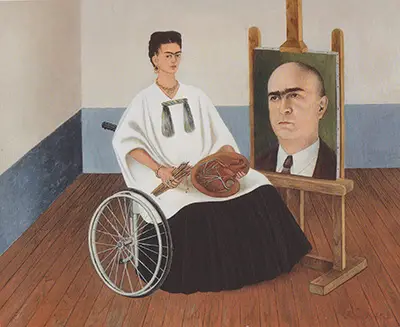In the year prior to the creation and completion of this painting, Kahlo had undergone seven surgeries on her spine.
These surgeries were performed by Doctor Juan Farill in Mexico City. Frida would spend nine months recovering in the hospital from this series of surgeries, which is indicated by the fact that she shows herself in a wheelchair.
This was the first painting she did after the surgeries as well as her last signed self-portrait, which makes is quite significant. The painting is also significant because this portrait within a portrait serves as a recognition to Doctor Farill for performing the surgeries.
Something quite interesting about this piece is how she painted Doctor Farill with the same sort of unibrow she always painted on herself. The unibrow is like her trademark, which she gives to her other subjects as well, seemingly to make it recognizable as her own work.
What should also be noted is the fact that her paint palette is represented as a heart. This is full of symbolism, another aspect of Frida's signature style.
The heart palette could represent different things. It could mean Frida is putting her heart into this painting for Doctor Farill in the same way he would have put his heart into the surgeries.
Perhaps it means Frida is going through a lot of pain to paint this picture as she would have still been recovering from the surgeries. It could also be a recognition that she would not be living if it were not for Doctor Farill.
Whatever her purpose was, Frida creates an interesting symbolism in using her heart as a paint palette. Another popular interpretation of this painting is that it serves as an "ex-voto retablo" for Doctor Farill. A retablo is a devotional painting common in Mexican folk art. This idea further supports the idea that this is a way of paying homage to Doctor Farill for his life-saving work.

